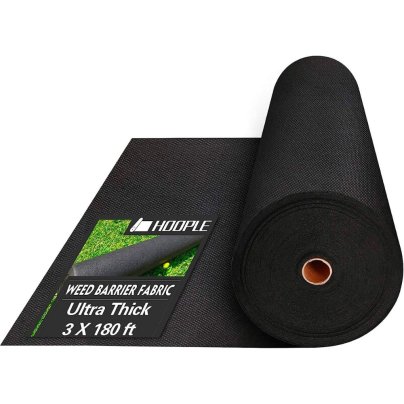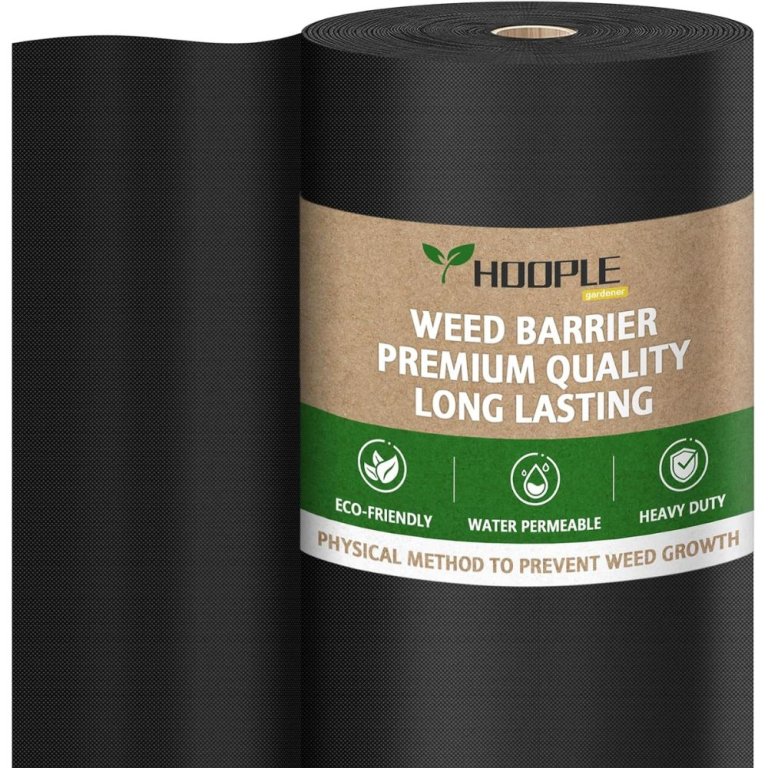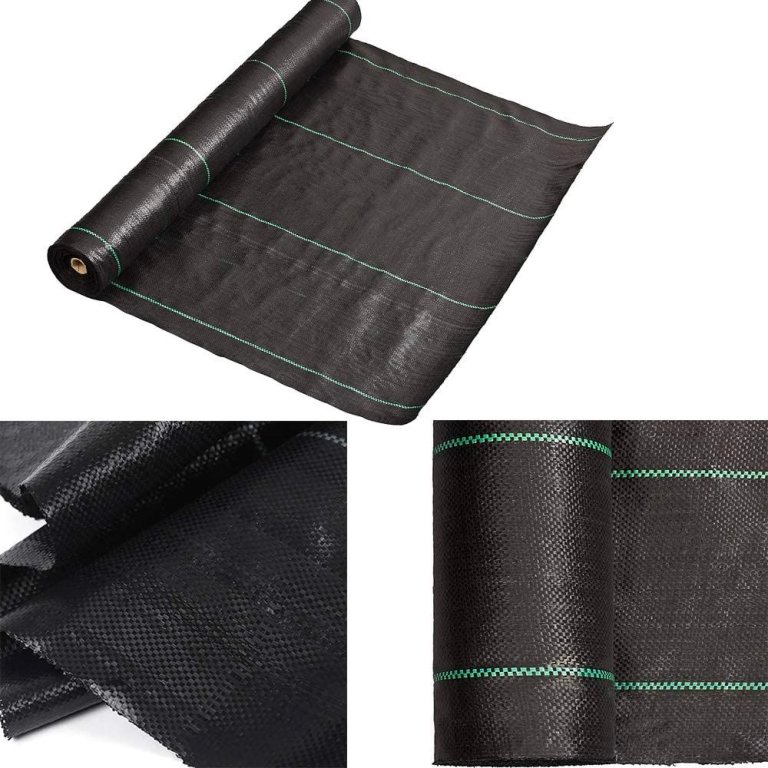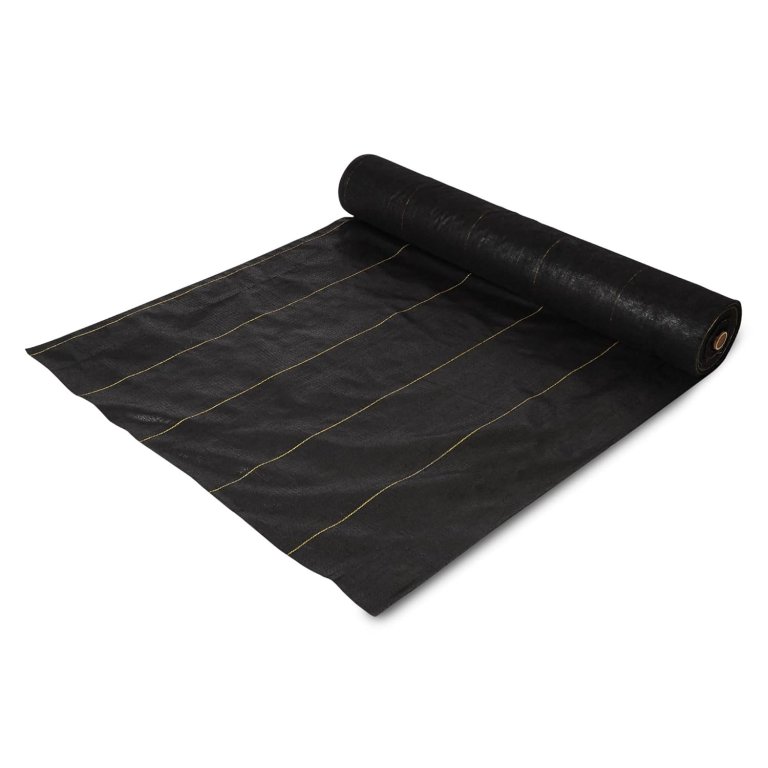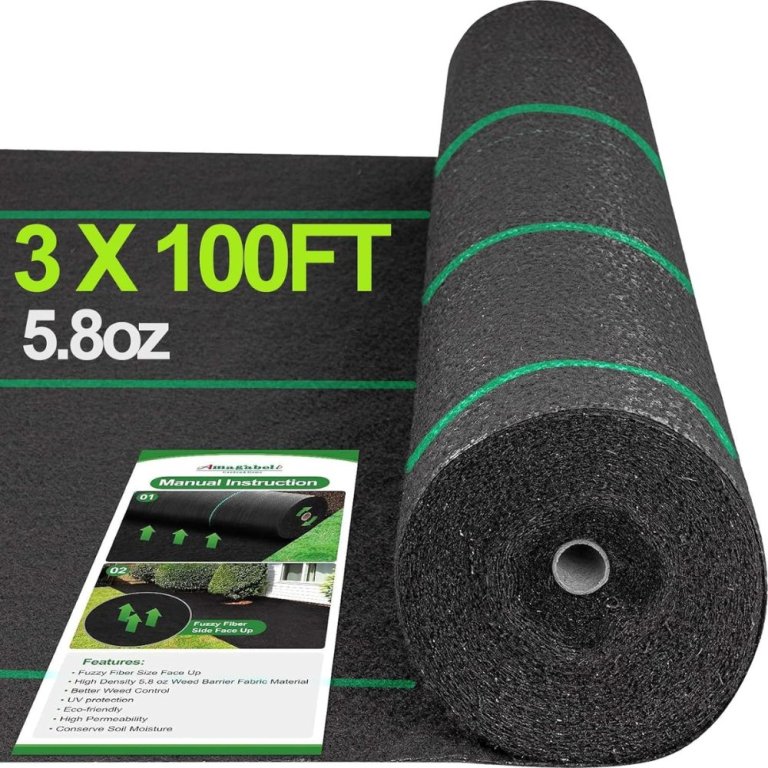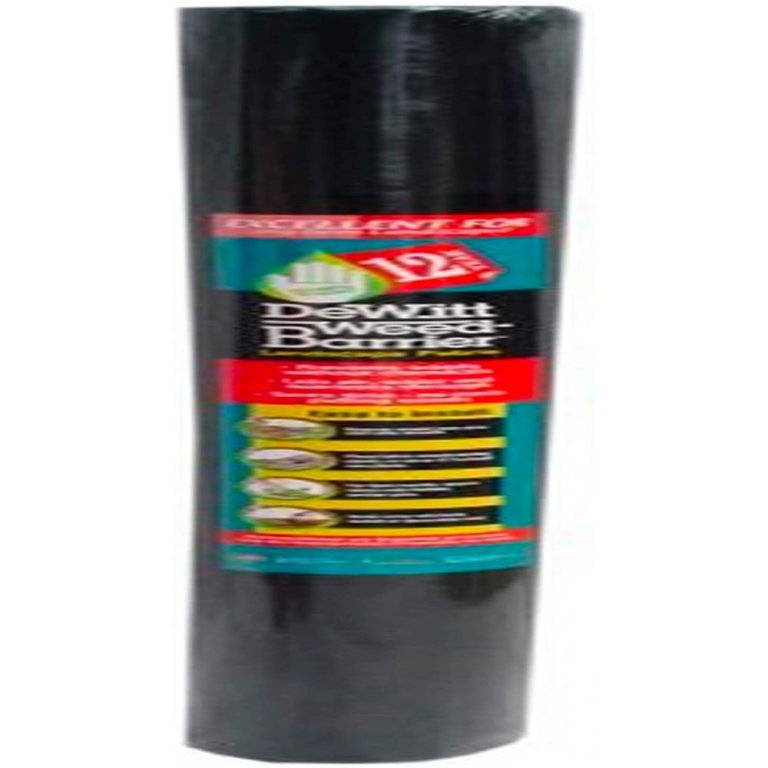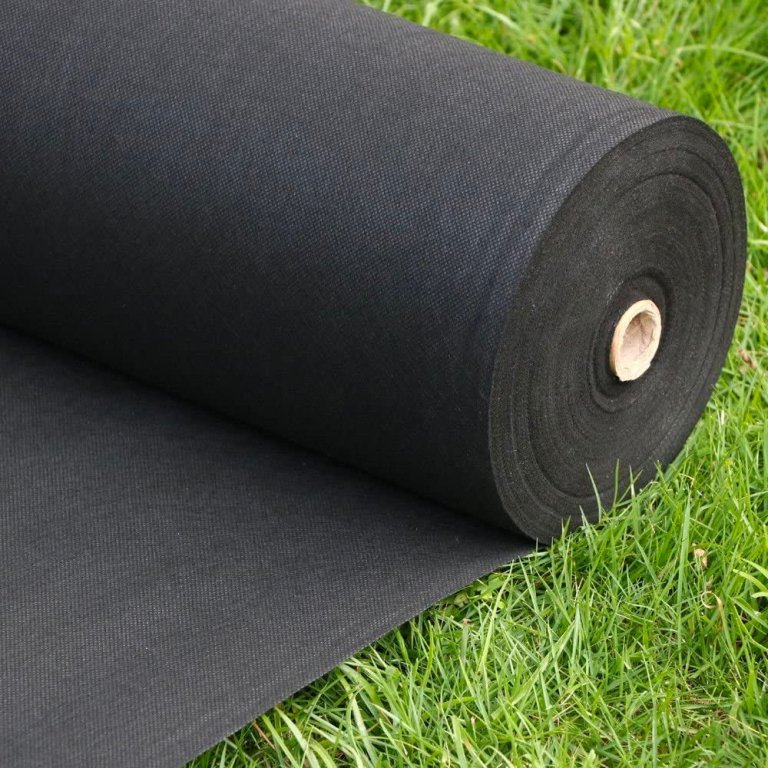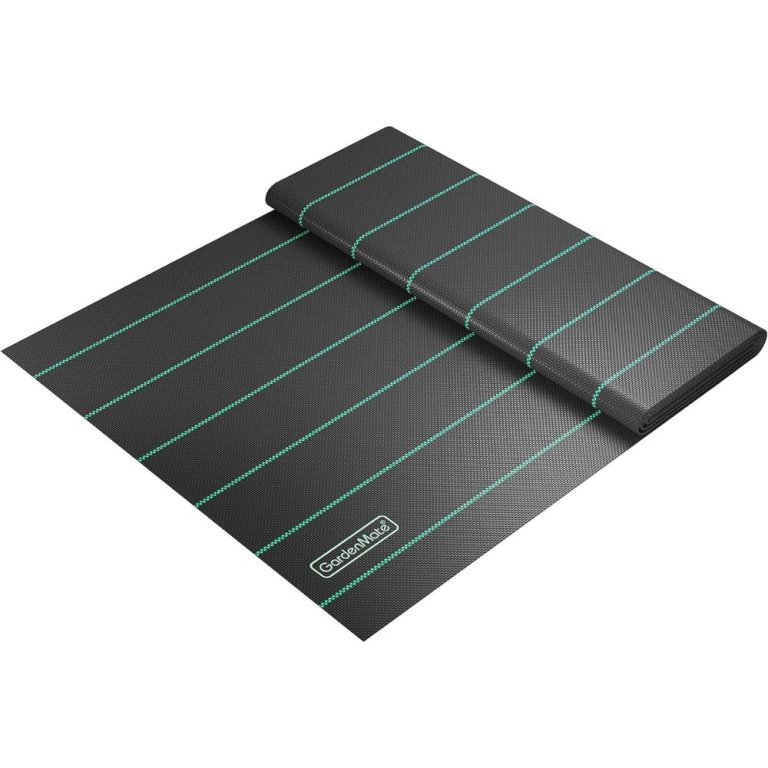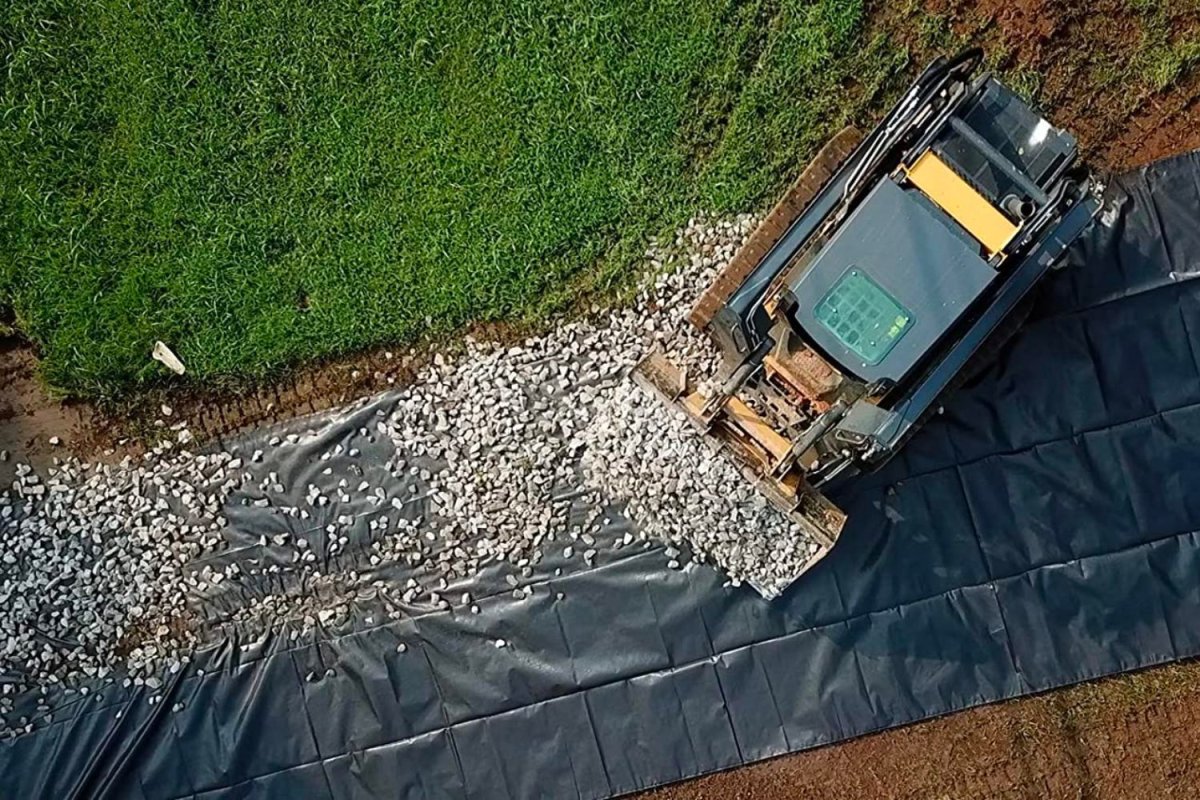
We may earn revenue from the products available on this page and participate in affiliate programs. Learn More ›
Whether we like it or not, weeds are part of every landscape, competing with your trees, shrubs, and flowers for vital nutrients. Landscape fabric could be your golden ticket to a weed-free landscape.
By acting as a physical barrier between the soil and the sun, landscape fabric prevents seeds from seeing the light of day while still allowing air and water to penetrate to the roots of the plants you do want.
To help bolster our own research, we interviewed Taylor Olberding, co-founder of Heroes Lawn Care, a nationwide lawn maintenance company, to get his professional advice on this useful gardening product.
Our favorite landscape fabric is the Hoople Garden Weed Barrier Landscape Fabric thanks to its thick, nonwoven, and ultraviolet (UV)-stabilized material with a highly permeable weave, which helps promote excellent irrigation.
Here are some important features to consider when selecting the best landscape fabric, as well as our top weed barrier picks for your landscape.
- BEST OVERALL: Hoople Garden Weed Barrier Landscape Fabric
↓ Jump to Review - BEST BANG FOR THE BUCK: Petgrow Heavy-Duty Weed Barrier Landscape Fabric
↓ Jump to Review - BEST FOR WEEDS: DeWitt Pro-5 Weed-Barrier
↓ Jump to Review - BEST AERATION: Amagabeli Garden & Home Weed Barrier Landscape Fabric
↓ Jump to Review - LONGEST LIFESPAN: DeWitt 12-Year Weed Barrier Landscape Fabric
↓ Jump to Review - BEST ECO-FRIENDLY: ECOgardener Premium Weed Barrier
↓ Jump to Review - BEST HEAVY-DUTY: Flarmor Landscape Fabric Weed Barrier
↓ Jump to Review - BEST FOR SMALL AREAS: Agtek Landscape Fabric Heavy-Duty Ground Cover
↓ Jump to Review - BEST FOR LARGE AREAS: GDNaid Weed Barrier Landscape Fabric
↓ Jump to Review - BEST FOR UNDER GRAVEL: ArmorLay Commercial Grade Driveway Fabric
↓ Jump to Review - ALSO CONSIDER: GardenMate Woven Weed Control Fabric
↓ Jump to Review
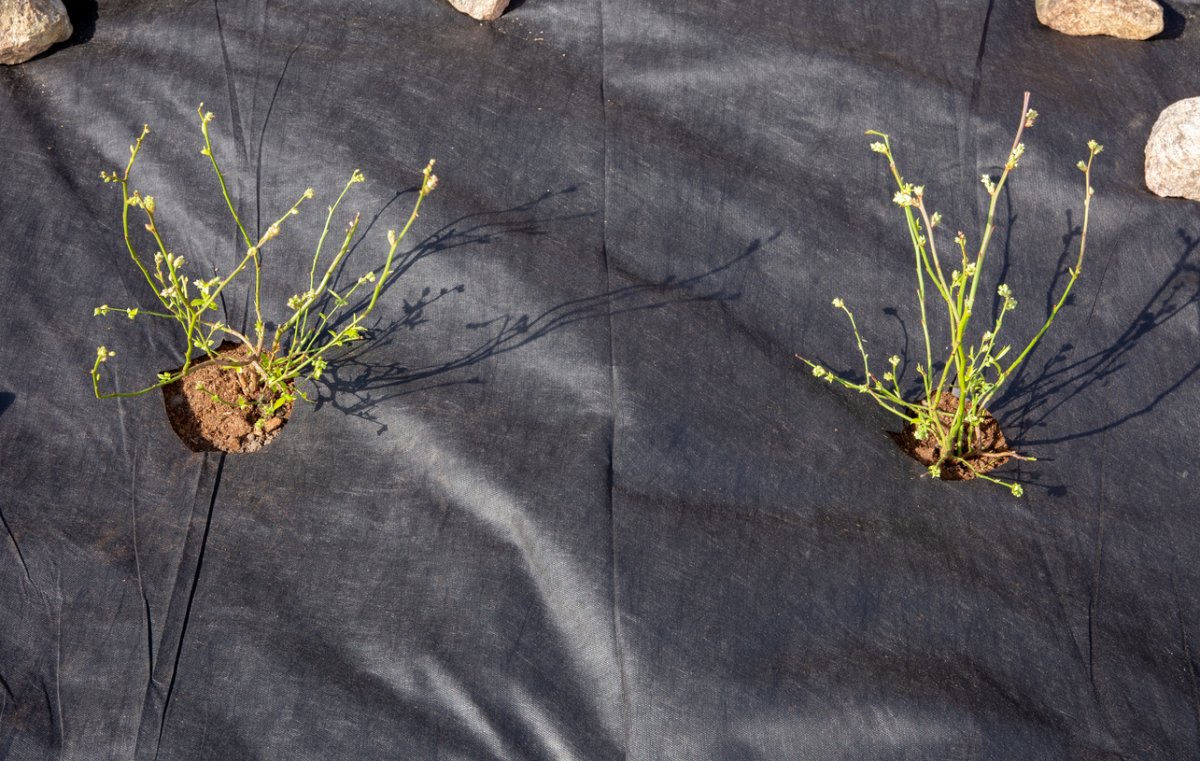
Before You Buy Landscape Fabric
In vegetable and flower gardens, gardeners frequently move or change plants, and access to the soil is vital to the health of the garden. Landscape fabric laid across the entire area would make amending the soil very difficult, if not impossible.
Instead, consider using it in the vegetable garden for weed suppression between rows. Soil erosion can occur when it’s been covered with landscape fabric and compacts over time as a result of the reduced earthworm population and poor aeration in these areas. Landscape fabric is best used beneath walkways or in areas with permanent trees and shrubs or no future planting plans.
How We Chose the Best Landscape Fabrics
Olberding shares his expertise with using weed barriers: “When it comes to durability, materials like heavy-duty woven fabric or thick plastic are great for withstanding moisture and regular wear and tear, ensuring prolonged protection for your garden beds.”
In terms of sustainability, Olberding adds that “for a more environmentally friendly option, you could consider biodegradable fabric crafted from recycled paper mulch or cornstarch. Paper mulch can last around 12 months and corn starch tends to biodegrade between 4 and 8 months. Both can effectively control weeds without harming the environment.”
Taking this professional advice in mind, we conducted extensive research that covered more than 30 different landscaping fabric products, which helped form the basis for the selection of the best landscape fabrics. However, to properly assess each product, it was necessary to take into account the size, material, thickness, and overall quality of each landscape fabric.
The size of each landscape fabric product was crucial information to have because the size is the primary factor that influences the price. The larger the landscape fabric, the higher the price. Given that landscape fabrics are separated into three different types, the material was the next aspect to consider. Most products were made with woven fabric, though there were a few standout non-woven landscape fabric options as well.
The durability of the product often comes down to the thickness, so for more heavy-duty jobs, it is necessary to find a thick weed barrier landscape fabric that can hold the weight without tearing. Some preference was given to products that were made for specific jobs, like increasing stability on a gravel path or serving as an underlay for artificial grass.
Our Top Picks
Best Overall
Hoople Garden Weed Barrier Landscape Fabric
What We Like
- 2 to 3 times thicker than the majority of its counterparts
- Built-in UV stabilizers prevent burning and plant damage
- Multiple sizes available for small to large flower beds
- Highly permeable in average precipitation for excellent irrigation
What We Don’t Like
- Not suitable for vegetable gardens
- Puddles quickly form in heavy rain
Product Specs
- Material: Fabric
- Type: Nonwoven
- Dimensions: 180 feet long by 32 inches wide
If the goal is to find a durable, nonwoven fabric for any landscape situation, the Hoople garden weed barrier fits the bill. Because it is two to three times thicker (at 5 ounces per square yard) than some other landscape fabrics, it tends to drain more slowly than those thinner options in heavy rainfall.
Still, the fabric remains highly permeable in average precipitation. The nonwoven fabric is durable enough to withstand the pressure of brick pavers and heavy stone, though it can also be used under gravel or mulch to add attractive layers to the landscape.
Whether the landscaping fabric is covered with organic mulches or not, ultraviolet (UV) stabilizers prevent it from rotting when exposed to direct sunlight, so you can rely on this landscape fabric to prevent weed growth for years. This roll measures 180 feet long by 32 inches wide, though it comes in other widths and lengths.
Get the Hoople landscape fabric at Amazon or Walmart.
Best Bang For The Buck
Petgrow Heavy-Duty Weed Barrier Landscape Fabric
What We Like
- Heavy-duty and eco-friendly construction with UV-stabilized materials
- Easy to install; lightweight and breathable construction lays easily
- Comes in multiple sizes depending on the outdoor space
What We Don’t Like
- May not be as heavy-duty if it is cut; the weed barrier fabric may unravel
Product Specs
- Material: Polypropylene
- Type: Nonwoven
- Dimensions: 100 feet long by 3 feet wide (other sizes available)
Those who need a budget-friendly weed barrier fabric can rely on this heavy-duty option from Petgrow. This fabric provides ample irrigation for plants and flowers with its needle-punched design and is made with chemical-free and corrosion-resistant polypropylene.
For users’ convenience, this UV-stabilized landscape fabric is 100 feet long by 3 feet wide but comes in many other sizes depending on the amount of land and garden space that needs to be covered. Plus, this weed barrier fabric has a 3.8-ounce thickness for weed control. Finally, this fabric is made with UV-stabilized materials to prevent any burning and sun damage.
Get the Petgrow landscape fabric at Amazon or Petgrow.
Best For Weeds
DeWitt Pro-5 Weed-Barrier
What We Like
- Landscape contractor-approved for professional use, yet easy to lay
- Heavy-duty 5-ounce woven fabric with UV resistance
- High-visibility stripes every 12 inches to help with planting alignment
What We Don’t Like
- Large rolls may be too much for some gardens (smallest size is 3 feet by 250 feet)
Product Specs
- Material: Polypropylene
- Type: Woven, needle-punched
- Dimensions: 5 feet wide by 250 feet long; other sizes available
Designed for professional and commercial use, this weed control fabric mat from DeWitt is a heavy-duty and effective option for serious gardeners. Used by landscape architects, government agencies, and professional contractors, this weed barrier is a sturdy and long-lasting choice.
The rolls are available in different sizes and are made from woven polypropylene and needle-punched fabric. This durable construction lets water, air, and essential nutrients through yet is an effective weed block. This thick landscape fabric won’t rot or develop mildew in damp areas, and it’s highly UV-resistant to prevent it from degrading in sunny conditions. It’s striped every 12 inches to assist users with alignment when planting garden beds.
Get the DeWitt Pro-5 landscape fabric at Amazon, Lowe’s (2-pack), The Home Depot (2-pack), or Walmart.
Best Aeration
Amagabeli Garden & Home Weed Barrier Landscape Fabric
What We Like
- Geotextile material is eco-friendly and provides excellent soil moisture
- Weatherproof and UV-stabilized needle-punched polyester prevents sun damage
- Comes in multiple sizes for small or large outdoor spaces
- Green stripes provide proper planting alignment
What We Don’t Like
- Some users have reported that weeds can sprout through
Product Specs
- Material: Geotextile polyester
- Type: Woven, needle punched
- Dimensions: 3 feet wide by 100 feet long; other sizes available
The Amagabeli Garden & Home landscape fabric provides irrigation and aeration to support the growth of healthy plants while keeping out weeds. It is made with a woven, needle-punched geotextile polyester material that promotes soil moisture and root growth. It’s also weatherproof and UV-stabilized, protecting plants from sun damage.
When it comes time to plant, this fabric can be cut and aligned with green stripes for vegetable patches, flower beds, gardens, driveways, and artificial grass. Though the 3-foot-wide by 100-foot-long strip accommodates 300 square feet, this roll of landscape fabric comes in multiple lengths.
Get the Amagabeli landscape fabric at Amazon.
DeWitt 12-Year Weed Barrier Landscape Fabric
What We Like
- Protective UV-resistant coating prevents plants from burning
- Hydrophilic treatment improves permeability and irrigation
- Long 12-year lifespan makes it reliable and durable
What We Don’t Like
- Small size isn’t suitable for large projects; may not be ideal for some users
Product Specs
- Material: Fabric
- Type: Woven
- Dimensions: 50 feet long by 4 feet wide
The lightweight woven fabric of DeWitt weed barrier landscape fabric is impressively durable with a guaranteed lifespan of up to 12 years before it needs to be removed and replaced. This landscape fabric roll measures 50 feet long by 4 feet wide, which is an excellent size for small garden beds, while the thickness of 1.5 ounces per square yard is suitable for low-traffic areas.
Despite the UV-resistant coating, this landscape fabric requires a layer of mulch after installation to protect it from direct sun exposure. Unlike other weed barriers prone to unraveling, DeWitt weed barrier fabric won’t fray when cut and has had hydrophilic treatment to allow for maximum water, air, and nutrient penetration. The fabric minimizes light penetration, which helps suppress weed growth.
Best Eco-friendly
ECOgardener Premium Weed Barrier
What We Like
- Eco-friendly polypropylene construction lasts for long-term use
- Dual-layered protection prevents weeds while providing proper irrigation
- Easy to install due to its lightweight construction
- Multiple sizes available for small to large landscapes
What We Don’t Like
- Untreated fabric must be covered to prevent UV damage
Product Specs
- Material: Fabric
- Type: Perforated
- Dimensions: 50 feet long by 3 feet wide
The thick, dual-layered, needle-punched fabric of the ECOgardener Premium weed barrier allows for optimal air and water circulation to promote plant growth while weed seeds are prevented from sprouting. Made of perforated woven polypropylene, this fabric is safe for the environment, ensuring that rain and snow runoff won’t release chemicals into the soil.
At just 5 pounds, the 50-foot-long by 3-foot-wide roll is lightweight and easy to install, though it’s still important to put landscape pins about once every foot to keep the landscape fabric secure. Because it’s untreated for sun exposure, it’s damaged easily by the sun, and anyone installing the weed barrier should cover the fabric with mulch immediately after installation. Leaving the fabric exposed to the sun will shorten its lifespan.
Get the ECOgardener landscape fabric at Amazon or EcoGardener.
Best Heavy-duty
Flarmor Landscape Fabric Weed Barrier
What We Like
- Dual-layered construction prevents weeds from permeating plants
- Highly permeable construction provides ample irrigation
- Heavy-duty durability lasts for years to come
- Multiple sizes available for small to large landscapes
What We Don’t Like
- Untreated fabric must be covered to prevent UV damage
Product Specs
- Material: Fabric
- Type: Perforated nonwoven
- Dimensions: 300 feet long by 3 feet wide
When the toughness of nonwoven fabrics is combined with the permeability of perforated landscape weed barriers, the result is an incredibly strong and versatile hybrid. Made of nonwoven polypropylene, the thick needle-punched fabric Flarmor weed barrier is highly permeable and equally effective beneath rocks and landscape beds, with a thickness of 1.8 ounces per square yard.
This fabric is also a great choice for covering sloped areas for weed and erosion control. However, Flarmor weed blocker will degrade quickly under direct sunlight, so it requires a covering of mulch or rock right after installation. The product comes in a 300-foot-long by 3-foot-wide roll, which is best suited for big jobs to minimize leftovers. It is also available in a 50-foot-long by 3-foot-wide size as well as several additional sizes so you can choose the most suitable length based on the size of the project.
The nonwoven fabric should not fray when cut, which adds to its lifespan. However, reapply mulch or gravel if the fabric becomes exposed to sunlight or it can deteriorate quickly.
Get the Flarmor landscape fabric at Amazon.
Best For Small Areas
Agtek Landscape Fabric Heavy-Duty Ground Cover
What We Like
- Small size is suitable for patios, walkways, and play structures
- Landscape fabric can be used with gravel or mulch
- Heavy-duty durability prevents tears
What We Don’t Like
- Fraying may occur when the fabric is cut or modified
Product Specs
- Material: Fabric
- Type: Woven
- Dimensions: 12 feet long by 4 feet wide
Dinner leftovers might be good for lunch the next day, but too much unused landscape fabric from a small project is frustrating. Unlike most fabric rolls that come in minimum lengths of 50 feet or more, the Agtek landscape fabric heavy-duty ground cover gives users smaller options so they don’t have to buy more than needed.
The smallest choice comes in a two-pack of 8-foot-long by 4-foot-wide pieces, but this product is also sold in a two-pack of 12-foot-long by 4-foot-wide pieces for slightly larger patios, playgrounds, or gardens. The heavy-duty woven polypropylene fabric drains well and it’s UV stabilized for impressive sun resistance. This Agtek landscape fabric’s thickness of 3.8 ounces per square yard is best for use beneath walkways, in playground areas, and on slopes to prevent erosion.
Get the Agtek landscape fabric at Amazon.
Best For Large Areas
GDNaid Weed Barrier Landscape Fabric
What We Like
- UV-stabilized material will not burn or damage plants
- Durable, heavy-duty fabric lasts for long-term use
- Impressive size for large projects; comes in multiple size options
What We Don’t Like
- Nonwoven fabric has reduced permeability
Product Specs
- Material: Fabric
- Type: Nonwoven
- Dimensions: 300 feet long by 3 feet wide
Gardens are meant to be enjoyed, but when it’s necessary to spend hours pulling weeds every week, a garden can soon seem like more work than it’s worth. Take back the garden and hardscape areas of the yard with this GDNaid weed barrier. It is made at a thickness of 1.8 ounces per square yard in a nonwoven polypropylene fabric.
The product comes in multiple sizes, though the most suitable for a large space is the 300-foot-long by 3-foot-wide option that allows you to protect up to 900 square feet of garden, path, or patio.
Many products require you to cover them with decorative mulch, gravel, or crushed stone to prevent damage from the sun, but it isn’t necessary with this landscape fabric due to the UV-stabilized polypropylene material. The nonwoven fabric is not as permeable as woven or perforated fabric, so it may not be the best choice for lush garden plants that need a lot of water.
Get the GDNaid landscape fabric at Amazon.
Best For Under Gravel
ArmorLay Commercial Grade Driveway Fabric
What We Like
- Highly durable to resist tearing; suitable for homes with pets running around
- Suitable for weed prevention and path stabilization
- Reduces erosion and prevents potholes from forming
What We Don’t Like
- Low water permeability; may not provide the best irrigation
Product Specs
- Material: Fabric
- Type: Nonwoven
- Dimensions: 60 feet long by 12.5 feet wide
While most landscape fabrics are put to use in the garden to help prevent weeds from sprouting up among the vegetables or flowers, ArmorLay nonwoven landscape fabric is designed for use under gravel paths, patios, and driveways. It serves the usual purpose of landscape fabric by preventing the growth of weeds, but this product also improves the stability of the ground.
Installing this layer of landscape fabric under a gravel path can minimize the damage caused by falling rain, sleet, and snow, protecting the soil from erosion and preventing potholes from forming. It’s about 8 ounces per square yard thick and measures 60 feet long by 12.5 feet wide, though multiple sizes are available.
Just keep in mind that the nonwoven construction has low water permeability, so this product is not a great option for garden beds.
Get the ArmorLay landscape fabric at Amazon.
Also Consider
GardenMate Woven Weed Control Fabric
What We Like
- Easy to customize the size and shape
- Suitable for small garden beds and outdoor spaces
- Built-in UV stabilizers prevent plants from burning
What We Don’t Like
- Small size may not be enough for large projects
Product Specs
- Material: Fabric
- Type: Woven
- Dimensions: 33 feet long by 6 feet wide
Instead of spending almost every weekend throughout the summer months just trying to tame the weed growth in the garden, install this GardenMate woven weed control fabric to prevent weeds from growing so the family can enjoy time off. The landscape fabric measures 6 feet by 33 feet.
At its size, this fabric is a great option for smaller garden beds or for use underneath patios or paths. However, if there is a large job that needs to be tackled, this probably isn’t the best product due to the small size.
The GardenMate landscape fabric has a thickness of 3 ounces per square yard, which is an ideal size for raised garden beds, rockeries, and gravel paths. The fabric is also treated with UV stabilizers to help prevent premature breakdown due to overexposure to the sun.
Get the GardenMate landscape fabric at Amazon.
Jump to Our Top Picks
What to Consider When Choosing a Landscape Fabric
Choosing the best landscape fabric for weed control is not a tough decision, but choices can vary based on the size of the job, foot traffic, whether you will cover the fabric, and the intended use of the area you’re protecting.
Woven, Nonwoven, and Perforated
Often made of polypropylene or linen, woven landscaping fabric is the most common weed barrier best suited for flower beds and areas around trees and shrubs. Small holes in this type of landscape fabric allow water, air, and nutrients to penetrate. For gravel gardens and pathways, consider the sturdier nonwoven option.
While it allows some water movement, nonwoven fabric isn’t as porous as its woven and perforated counterparts, so it’s not the best choice for landscaped beds. Highly permeable perforated landscape fabric is lightweight and ideal for areas with less foot traffic, specifically vegetable gardens and raised beds.
Thickness and Durability
Generally, the thicker the landscape fabric, the more it costs. Choose thicker barriers in gravel areas like pathways where rocks can wear away thinner fabrics over time. Tough unwanted weeds also are worth considering, since some—like thistle—can grow through weak barriers.
Avoid heavy weed barriers around vegetables, herbs, and annuals because their roots can lie close to the surface and can be crushed beneath the weight. Choose thinner, perforated options for these applications.
UV Resistance
Exposure to the sun’s ultraviolet rays has damaging effects on many surfaces, including landscape fabric. For this reason, these barriers often require spreading a layer of mulch or gravel over the fabric to decrease exposure to UV light, thereby slowing the breakdown of the material.
Many barriers are labeled UV-resistant or UV stabilized. “Resistant” implies that the fabric has innate qualities that make it less susceptible to damaging sunlight. Those labeled “UV stabilized” have been chemically coated to repel ultraviolet light. If chemicals are out of the question, like around edible plantings, choose the UV-resistant option.
Size of Roll for Project
Most weed barriers come in convenient rolls that are easy to transport and use. A weed barrier roll should display the fabric size, which you can use to calculate how much ground a roll can cover. Make sure to account for roughly an 8-inch overlap for areas that require several pieces of weed barrier fabric.
Weed barrier rolls are typically 3 to 6 feet wide and can range from 50 to upwards of 200 feet long. For large coverage areas, consider a wider roll to cover areas faster.
When comparing similar-size barriers, a thicker and heavier roll tends to mean thicker and longer-lasting fabric. As is the case with most home products, professional-grade products tend to be costlier, but they can have added benefits such as being made of more durable materials or offering better UV resistance.
Lifespan
In a perfect world, laying landscape fabric would be a one-and-done job. It’s not hard to do, but it is time-consuming and difficult to repeat when aged landscape fabric needs to be replaced around an established landscape. Selecting the right weed barrier for the right application is key to getting the biggest bang for your buck.
Some weed barriers estimate how long you can expect the product to last in your landscape. Longevity depends on a number of factors, including temperature, application, exposure, and moisture specific to the area where it’s installed.
Eco-Friendliness
The most common weed barriers available at stores or online are made from materials such as polypropylene and polyester, which are not particularly eco-friendly. Barriers made from natural fibers such as burlap or linen can be a more eco-friendly option, since they break down faster than plastics. Regardless of the material, choosing a durable option, using the barrier for as long as possible, and disposing of it correctly can reduce your ecological footprint.
For the most eco-friendly option, consider natural barriers such as organic mulches, straw, peat moss, or other organic materials. Using natural barriers requires more work, but since these materials are biodegradable, they are the most environmentally conscious option.
Tips for Using Landscape Fabric
Installing a weed barrier is a relatively straightforward process. First, measure the area where you intend to lay the weed barrier to calculate the number of rolls required—and as with most home projects, it doesn’t hurt to buy a little extra. Make sure to choose a weed barrier that is suitable for your intended use; for example, choose a thicker and impermeable barrier for under pathways, as compared to a thinner, permeable barrier for a garden bed. Once you’ve purchased the weed barrier, preparation is an important step. To prepare the area and install the weed barrier, follow these steps:
- Clear the area of debris, weeds, grass, and other vegetation for the most effective coverage (aside from any plants you intend to keep, of course!).
- If applicable, add any chosen soil amendments (like compost manure or peat moss) to nurture the soil under the barrier—it is less effective to add them after the weed barrier is placed.
- Level the soil with a rake; remove sharp objects, rocks, and roots; and lay down the weed barrier according to the manufacturer’s instructions.
- Use pegs or garden staples every few feet to pin the barrier in place for a sturdy hold, reliable protection, and a more seamless look. Sandbags or rocks are another option, as are other decorative landscaping elements.
- Optionally, spread a layer of mulch, rocks, or gravel over the barrier. This decorative layer can improve your garden’s appearance, cut down on UV damage on the barrier, retain soil moisture, and further block weed growth.
FAQs
Some types of landscape fabrics aren’t always easy to install, but these weed barriers help to protect flower beds and prevent weed growth. Keep reading to find the answers to some of the most commonly asked questions about weed barrier landscape fabric.
Landscape fabric is typically separated based on the type of material used to make the product. The types of landscape fabrics include woven, perforated, and nonwoven landscaping fabric.
Each type of landscape fabric has its own benefits depending on the application, so think about whether you are looking to protect a flower bed, vegetable garden, or a walkway when deciding on the best weed control solution for your next landscaping project.
Landscape fabric is designed to block out UV radiation as well as prevent weed seeds from growing, but this weed barrier fabric allows water and some air to pass through. This is possible due to the construction of the fabric.
Even thick and durable fabric is either woven or has perforated holes to allow water to seep into the ground, though it should be noted that some fabrics can greatly reduce the flow of water, leading to standing puddles after big rainstorms.
Filter fabric is a similar product to landscape fabric, but it’s usually thinner and doesn’t have the same UV resistance, leaving it susceptible to premature degradation. To protect your flower beds, invest in thick and durable fabric that will be able to block the weeds and stand up to the sun and rain.
In most cases, landscape fabric is laid down and secured over the soil in a garden or around the base of a tree or bush in the yard. After the installation, you can put organic mulches on top of the landscape fabric to protect the fabric from foot traffic and UV rays. You also can use gravel or crushed rock as the top layer.
The purpose of landscape fabric is to prevent weed growth. This is achieved by pulling all the weeds in the garden and then installing landscaping fabric directly over the soil. Some users also put sand or gravel underneath the landscaping fabric to help level the ground, though this isn’t necessary. This is especially true since mulch, gravel, and crushed stone are often spread over the top of the fabric.
